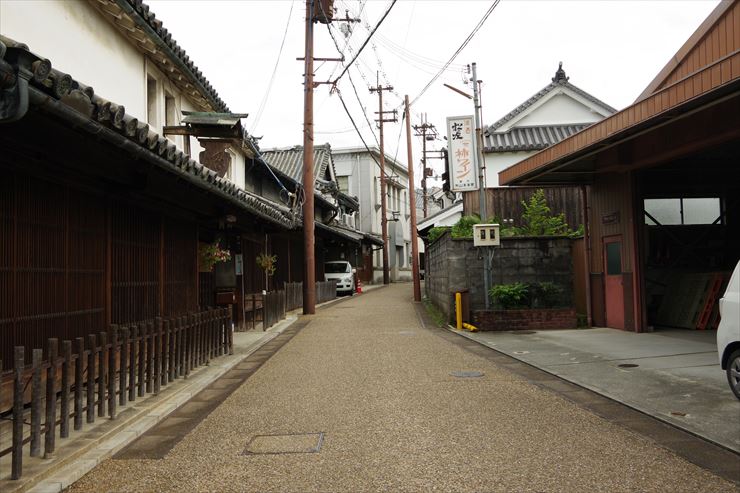

Gose and Gojo are areas famous for their still remaining old-style streetscapes and old roads. In these tranquil towns with abundant nature, artisans have been carrying on the traditional culture.


Gose and Gojo are areas famous for their still remaining old-style streetscapes and old roads. In these tranquil towns with abundant nature, artisans have been carrying on the traditional culture.

It has been three years since I started polishing Japanese swords. Working with swords, I feel I naturally came to acquire good manners and proper behaviors and actions. We polish swords to pursue beautility (functional beauty). The key point of sword polishing is to polish it without ruining the original shape. I believe that my role as a sword polisher is to pass on the tradition to the future. 
Currently, Japanese swords are attracting worldwide attention as Japanese artistic works. In the Edo period, although there were still samurai, it was basically a war-free era. Therefore, swords changed their role from a tool for fighting to part of a dress code for samurai, which should be worn in public. Back then, swords were considered a way of expressing the authority and aesthetic sense of samurai and each samurai was fussy about the swords they had and wore in their personal possession. 
At the atelier of Mr. Okoshi, you can observe the process of Japanese sword polishing.
*Please contact us in advance by e-mail.
aktm.ohkoshi@gmail.com [nlink url=”https://att-japan.net/en/archives/5664″]
| Access | about 8 min by car from Kintetsu Gose Sta. (Kintetsu Gose Line) and JR Gose Sta. (JR Wakayama Line)About 3 min on foot from Toyoda bus stop (on Gose City community bus) |

Bonsai is an art to express the beauty of nature by putting part of the natural landscape into a pot or tray. As a pioneer of bonsai craftsman in Nara, Mr. Takahashi, who has been keeping up a tradition of about 100 years, sees bonsai like his family member, which he continually fosters with care and affection. The process itself of growing bonsai is the art work of bonsai, and we work hard to draw out the essential beauty of a tree. From February 9 to March 3, 2019, “bonbai,” plum bonsai, will be exhibited at Osaka Tenmangu Shrine. 
Developed from the Edo period, bonsai is now attracting not only Japanese people but also foreign visitors. At Taihakuen, we grow and sell various kinds of bonsai, including shinpaku (Chinese juniper), kuromatsu (Japanese black pine), momiji (Japanese maple tree), and ume (plum tree) 
*Please contact us in advance by phone or e-mail.
0745-62-3613/taihaku@chive.ocn.ne.jp
| Access | Taihakuen: about 15 min on foot from Kintetsu Gose Sta. (Kintetsu Gose Line) and JR Gose Sta. (JR Wakayama Line) |
| URL | https://taihakuen.wixsite.com/bonsai |

Established in 1924 in Gojo City located at the foot of Mt. Kongo, Gojo Shuzo Brewery has been making sake only with the finest-quality local ingredients, including water from the surrounding mountains and the well on the premises, and rice grown in Nara Prefecture. The key factors in sake making are: 1) koji, 2) shubo, and 3) tsukuri. A toji, or chief brewer at a sake brewery, manages and controls all of these sake-making processes, creating delicious sake with a perfect balance. Our main product is “Goshin.” This sake is moderately dry with some sweetness and a modest aroma. I recommend that you drink sake to accompany a meal. 
Every year in mid-October, a toji comes from Tajima, the north part of Hyogo Prefecture, and begins the brewing of sake, which continues until April. Based on living materials, including koji mold and yeast, sake production is a very delicate and difficult process. The taste changes dramatically depending on the ingredients, humidity, and time; therefore, it is important to make sure that skilled workers control the process with their own eyes, in order to produce sake that really satisfies people who drink it

Our main product, “Goshin,” has long been patronized by local people, who call it Goshin-san. “Daiginjo,” which is especially popular among foreigners, is made with polished rice grains that have been carefully washed by hand. The production starts in January, with thorough time management throughout. Recently, we have also started selling liqueurs, which are popular among women.

*If you wish to look around the brewery, please contact us in advance.
http://sake-goshin.com/en/index.html/info@sake-goshin.com
| Access | 4 min on foot from Gojo Sta. |

Nara Kotsu Expressway Bus (5,980 yen to 10,500 yen)
https://japanbusonline.com/en/CourseSearch/12900010001
| URL | https://nakako-syoyu.jp/ |